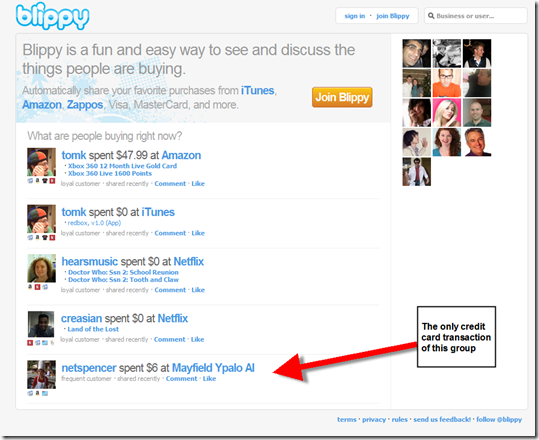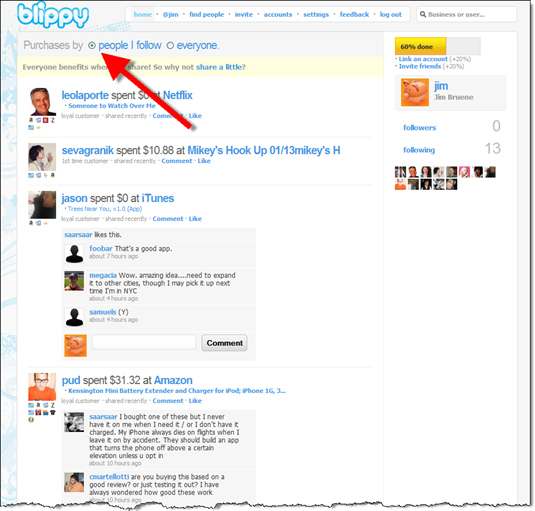 To give you an idea of the types of innovations being funded in financial services these days, here’s a capsule description of the first 48 companies demoing at FinovateStartup April 28 in San Francisco (note 1).
To give you an idea of the types of innovations being funded in financial services these days, here’s a capsule description of the first 48 companies demoing at FinovateStartup April 28 in San Francisco (note 1).
Attention attendees: You have just one day left to register (here) at the discounted price of $795.
Finovate Startup 2009 Participants
Acculynk
Acculynk is a payments solutions provider with a suite of software-only services that secure online transactions by utilizing a graphical, scrambling PIN-pad for the secure entry of sensitive cardholder information.
AlphaClone
AlphaClone is a web-based investment research service that lets users explore the investing ideas of top hedge fund and institutional money managers.
Aradiom
Aradiom is a mobile solutions provider and designer of Java mobile applications and platform development technology including turn-key applications, embedded soft-token security solutions and BlackBerryĀ® enterprise applications.
BillShrink
BillShrink is a personalized savings advisor that helps consumers make smart, money-saving decisions by providing continuously updated, personalized, usage-based recommendations on everyday services like credit cards and cell phone plans
BudgetTracker
BudgetTracker is a personal finance manager that allows users to manage their finances and keep track of their budget, bills, and transactions online without having to install software.
CalendarBudget
CalendarBudget is a free online personal budgeting tool that helps users organize and track their finances, plan future spending and save money.
Centrro
Centrro is a financial search engine that allows consumers to anonymously shop for personal financial products that best fit their specific credit profile.
CircleUp
CircleUp provides group communications services, which enable actionable and efficient interactions across diverse social, email, mobile, messaging and private web networks.
Cooler Inc.
Cooler Inc. enables users to know, decrease, and offset the global warming impact of their everyday purchases and activities by using the country’s only peer-reviewed carbon calculator to calculate impact and then providing reductions targets and strategies, and offering recommendations on high quality carbon offsets.
CreditArray
CreditArray is a vault of proprietary information to allow consumers to better apply for and manage their credit portfolios.
Credit Karma
Credit Karma provides consumers free access to their credit score and offers credit simulators, advice, and credit score comparison tools in order to allow them to more actively manage their credit and financial health.
GoalSpring
GoalSpring’s product, DebtGoal, makes paying down debt as easy and efficient as possible by taking into account all of a customer’s debt and helping them organize, optimize and pay it down.
Expensify
Expensify simplifies keeping track of business expenses by combining an electronic payment card and a web-based expense manager to automate expense report preparation, approval, and reimbursement.
Green Sherpa
Green Sherpa offers personal cash flow management software that lets users conveniently download, manage and update all their financial accounts via a single online resource.
Home-Account
Home-Account is in stealth mode at this time.
HomeATM
HomeATM provides a secure PIN debit and PIN credit card transactions method via the Internet that utilizes the HomeATM swipe pad technology to allow users to conduct secure PIN-based transactions from home, ensuring virtually zero fraud and lower merchant processing fee costs.
iBearSoft
iBearSoft is the creator of iBearMoney, a personal finance application for the iPhone that allows users to input and categorize their transactions, run financial reports, analyze payments, and keep track of expenses.
iThryv
iThryv is a financial literacy platform that combines a content delivery system and an incentive system in order to create an immersive learning environment which provides a powerful tool when used in partnership with online banking and core providers.
Jwaala
Jwaala provides software for banks and credit unions that improves their online banking services. Their MoneyTracker application offers a personal financial management solution that can be added to any bank or credit union’s existing online banking solution.
kaChing
kaChing is a social investment community that applies an open source and social-networking strategy to offer every investor the opportunity to find outstanding investors, emulate their portfolios, and access the returns, insights, transparency and talent previously only available to wealthy individuals.
Kapitall
Kapitall is a rich web application that aims to make investing easy for everyone. Inspired by game design, Kapitall combines an graphical user interface with tools that make it easier than ever to research companies, build portfolios, share ideas and get smarter about the market.
Lending Club
Lending Club is an online social lending network where people can borrow and invest money at attractive rates.
LendingKarma
LendingKarma is a person-to-person lending site that makes it easy for parties that know each other to create loans and provides borrowers and lenders with tools to help service the loan and see it through to repayment.
Looniesdesk.com
Looniesdesk.com enables people to manage their finances online using an open source financial platform that allows developers to build sophisticated applications which will help users enhance their experience and increase the efficiency of the service.
Mint
Mint is an online per
sonal finance service that securely downloads users’ financial transactions, allows them to categorize their transactions, provides a unified view of all account activity and relevant account alerts, and offers personalized suggestions for significant savings opportunities.
Moneta
Moneta provides a secure, quick and easy form of online payment that directly debits users’ checking or money market account allowing users to only enter a secure username and password when making online purchases.
NCore
NCore provides enterprise class delivery channel solutions to financial institutions within the Asia Pacific and Middle East regions fusing applications, innovative security and middleware technology into a single integrated platform.
OurCashFlow
OurCashFlow offers personal finance management tools for financial institutions that can turn their website into a place where customers can create a budget, save money and achieve their savings goals.
Pennyminder
Pennyminder helps individuals and small groups manage their shared and personal finances by tracking deposits and withdrawals allowing them to see what’s happening with their money
People Capital
People Capital is a peer-to-peer private student loan service that utilizes a unique scoring system to predict a student’s potential and provide a true, unbiased measure of the economic value of an education that empowers students to make better educational decisions and offers multiple advantages for both borrowers and lenders.
Pertuity Direct
Pertuity Direct offers social lending for personal loans by bringing together the advantages of capital markets, social networks and traditional banking.
Portfolio Monkey
Portfolio Monkey provides free online portfolio management tools to help average investors optimize their portfolios and find customized investment ideas so they can create more efficient portfolios with higher expected return and less risk.
Prosper
Prosper is a person-to-person lending marketplace where people list and bid on loans using Prosper’s online auction platform.
The Receivables Exchange
The Receivables Exchange is a real-time online market for trading accounts receivable that gives businesses access to working capital at a competitive cost by connecting a global network of accredited investors to the nation’s small and mid-sized businesses.
Rudder
Rudder is a free personal finance software designed to minimize the effort required in managing money by helping users to manage their budget, track their bills and analyze their expected income and projected expenses.
Silver Tail Systems
Silver Tail Systems provides fraud prevention to defend users’ websites against business logic abuse through the use of behavior detection, efficient investigation and real-time mitigation to track suspicious behavior and divert the bad actors, leaving legitimate users unaffected.
SimpliFi
SimpliFi provides independent financial advice online. Users can complete a profile and receive a personal financial plan with specific actionable steps.
SmartHippo
SmartHippo uses the power of the community to find users the best rates on financial products and services.
SmartyPig
SmartyPig is a social saving service that helps users save for a specific goal by allowing them to invite others to contribute to their account, providing incentive boosts from top retailers, and offering a competitive interest rate.
Strands
moneyStrands is a money management service that helps users get information on anything from practical savings tips to getting help tracking expenses down
Syphr
Syphr is a technology and marketing credit union service organization that created RateMatch, a service that matches participating credit unions with the thousands of credit report purchasers per month.
ThreatMetrix
ThreatMetrix helps companies control online fraud and abuse in real time by profiling the device used in an online transaction so companies can determine whether the users are fraudsters or customers.
Transparent Financial Services
Transparent Financial Services is online comparison-shopping service for small businesses that uses technology to help users compare and purchase financial services like payroll processing, credit card processing and business loans.
Victrio
Victrio offers a credit risk management system that uses voiceprint recognition technology to fight credit card fraud and identity theft.
Wesabe
Wesabe is an online personal finance management tool that provides members with information about where they spend and links them with a community dedicated to helping each other make smart financial decisions.
WeSeed
WeSeed seeks to demystify the stock market by helping real people share what they know and make smart investing decisions based on the collective wisdom of the community.
ZimpleMoney
ZimpleMoney is a web-based financial services platform enabling people and organizations to manage and administer financial agreements including loans, leases, rentals, tithing, trusts and settlements.

Note
1. Several other participants are remaining anonymous for the time being.
 From a financial innovations standpoint, 2010 is off to a great start. Just 35 days into the year and we’ve already had two launches of services I don’t think anyone saw coming: Blippy to automatically stream your purchases to the world (previous post) and now Kwedit (say it out loud if you don’t get it).
From a financial innovations standpoint, 2010 is off to a great start. Just 35 days into the year and we’ve already had two launches of services I don’t think anyone saw coming: Blippy to automatically stream your purchases to the world (previous post) and now Kwedit (say it out loud if you don’t get it).  Many of the gaming networks, especially the so-called “social gaming” startups such as Zynga’s FarmVille, appeal to teenagers and younger kids (note 1) who don’t have credit or debit cards available to pay for virtual goods. This has made it difficult for the publishers to monetize the games through direct payments.
Many of the gaming networks, especially the so-called “social gaming” startups such as Zynga’s FarmVille, appeal to teenagers and younger kids (note 1) who don’t have credit or debit cards available to pay for virtual goods. This has made it difficult for the publishers to monetize the games through direct payments.  directly to Kwedit, or “pass the duck” and send the IOU direct to their parents for payment. The site also offers an option to pay directly via credit or debit card.
directly to Kwedit, or “pass the duck” and send the IOU direct to their parents for payment. The site also offers an option to pay directly via credit or debit card.






































![clip_image002[8]](http://s3.amazonaws.com/finovate-archive/old/WindowsLiveWriter/LowerMyAssessment.comLauncheswith125Fee_E0C1/clip_image002%5B8%5D_thumb.jpg)







